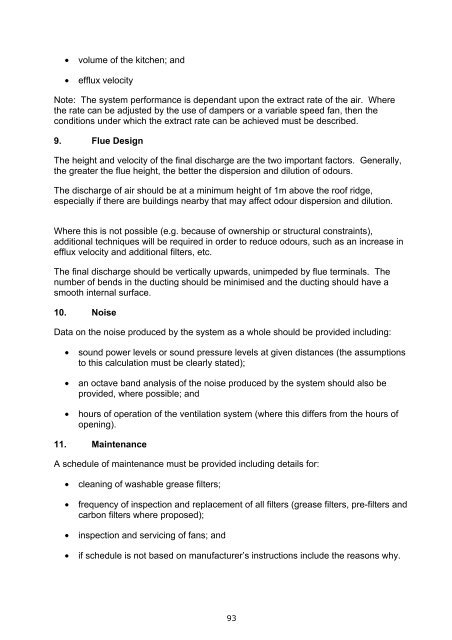Guidance on the Control of Odour and Noise from ... - Defra
Guidance on the Control of Odour and Noise from ... - Defra
Guidance on the Control of Odour and Noise from ... - Defra
Create successful ePaper yourself
Turn your PDF publications into a flip-book with our unique Google optimized e-Paper software.
• volume <strong>of</strong> <strong>the</strong> kitchen; <strong>and</strong><br />
• efflux velocity<br />
Note: The system performance is dependant up<strong>on</strong> <strong>the</strong> extract rate <strong>of</strong> <strong>the</strong> air. Where<br />
<strong>the</strong> rate can be adjusted by <strong>the</strong> use <strong>of</strong> dampers or a variable speed fan, <strong>the</strong>n <strong>the</strong><br />
c<strong>on</strong>diti<strong>on</strong>s under which <strong>the</strong> extract rate can be achieved must be described.<br />
9. Flue Design<br />
The height <strong>and</strong> velocity <strong>of</strong> <strong>the</strong> final discharge are <strong>the</strong> two important factors. Generally,<br />
<strong>the</strong> greater <strong>the</strong> flue height, <strong>the</strong> better <strong>the</strong> dispersi<strong>on</strong> <strong>and</strong> diluti<strong>on</strong> <strong>of</strong> odours.<br />
The discharge <strong>of</strong> air should be at a minimum height <strong>of</strong> 1m above <strong>the</strong> ro<strong>of</strong> ridge,<br />
especially if <strong>the</strong>re are buildings nearby that may affect odour dispersi<strong>on</strong> <strong>and</strong> diluti<strong>on</strong>.<br />
Where this is not possible (e.g. because <strong>of</strong> ownership or structural c<strong>on</strong>straints),<br />
additi<strong>on</strong>al techniques will be required in order to reduce odours, such as an increase in<br />
efflux velocity <strong>and</strong> additi<strong>on</strong>al filters, etc.<br />
The final discharge should be vertically upwards, unimpeded by flue terminals. The<br />
number <strong>of</strong> bends in <strong>the</strong> ducting should be minimised <strong>and</strong> <strong>the</strong> ducting should have a<br />
smooth internal surface.<br />
10. <strong>Noise</strong><br />
Data <strong>on</strong> <strong>the</strong> noise produced by <strong>the</strong> system as a whole should be provided including:<br />
• sound power levels or sound pressure levels at given distances (<strong>the</strong> assumpti<strong>on</strong>s<br />
to this calculati<strong>on</strong> must be clearly stated);<br />
• an octave b<strong>and</strong> analysis <strong>of</strong> <strong>the</strong> noise produced by <strong>the</strong> system should also be<br />
provided, where possible; <strong>and</strong><br />
• hours <strong>of</strong> operati<strong>on</strong> <strong>of</strong> <strong>the</strong> ventilati<strong>on</strong> system (where this differs <strong>from</strong> <strong>the</strong> hours <strong>of</strong><br />
opening).<br />
11. Maintenance<br />
A schedule <strong>of</strong> maintenance must be provided including details for:<br />
• cleaning <strong>of</strong> washable grease filters;<br />
• frequency <strong>of</strong> inspecti<strong>on</strong> <strong>and</strong> replacement <strong>of</strong> all filters (grease filters, pre-filters <strong>and</strong><br />
carb<strong>on</strong> filters where proposed);<br />
• inspecti<strong>on</strong> <strong>and</strong> servicing <strong>of</strong> fans; <strong>and</strong><br />
• if schedule is not based <strong>on</strong> manufacturer’s instructi<strong>on</strong>s include <strong>the</strong> reas<strong>on</strong>s why.<br />
93
















